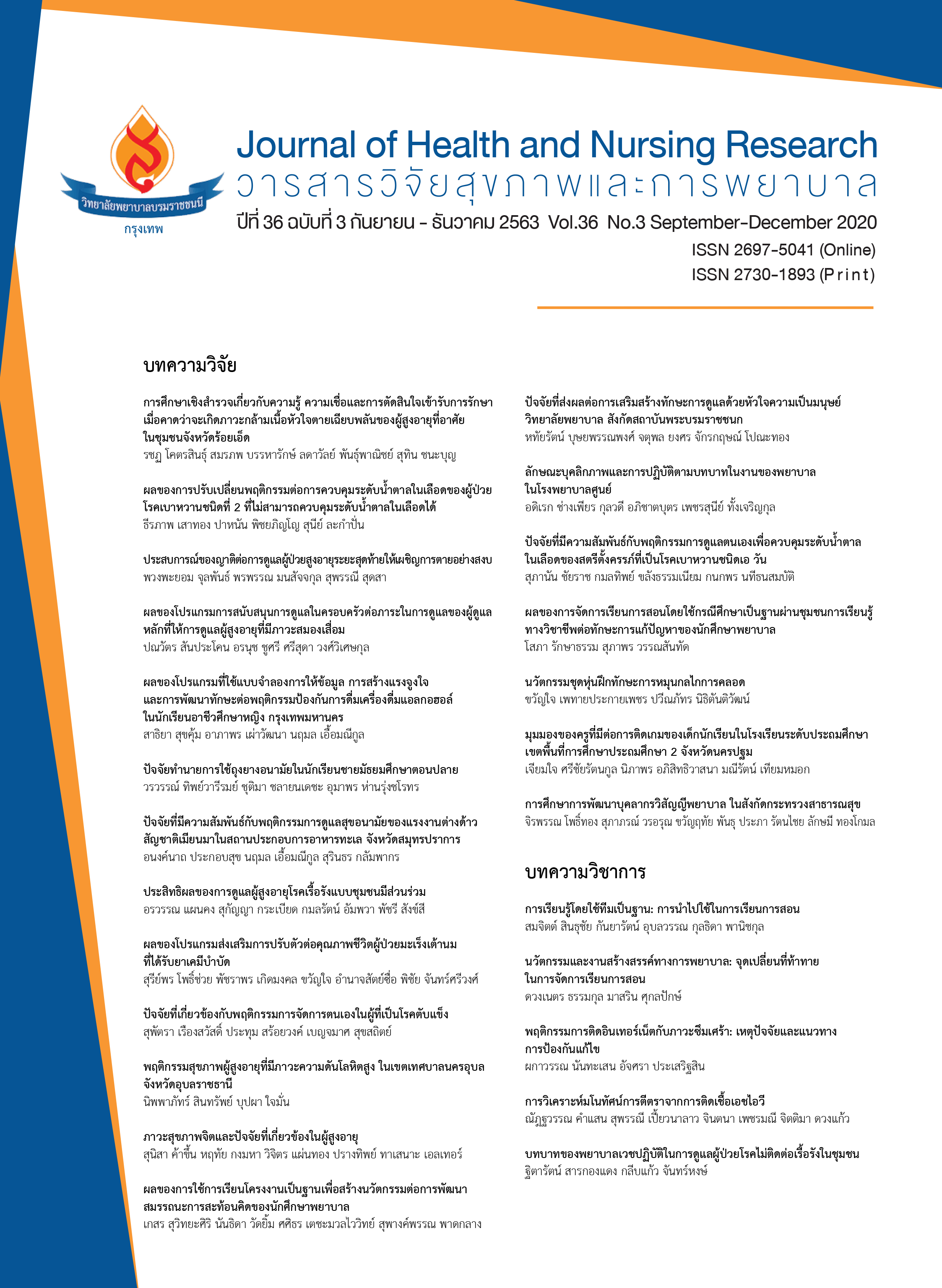การเรียนรู้โดยใช้ทีมเป็นฐาน: การนำไปใช้ในการเรียนการสอน
คำสำคัญ:
การเรียนรู้โดยใช้ทีมเป็นฐาน, การเรียนการสอนบทคัดย่อ
การเรียนรู้โดยใช้ทีมเป็นฐานเป็นกลยุทธ์การสอนที่ออกแบบให้ผู้เรียนมีส่วนร่วมในการเรียนรู้ผ่านการทำงานร่วมกันเป็นทีม ประกอบด้วย 3 ขั้นตอน ได้แก่ การมอบหมายงานให้ผู้เรียนศึกษาค้นคว้าด้วยตนเอง การรับประกันความพร้อมของผู้เรียน และขั้นสุดท้ายซึ่งเป็นขั้นตอนที่สำคัญที่สุดคือ การประยุกต์ใช้ความรู้ในการแก้ปัญหาจากสถานการณ์ในคลินิก บทความนี้อธิบายกระบวนการเรียนการสอนโดยใช้ทีมเป็นฐานและการนำไปประยุกต์ใช้ตั้งแต่ การเตรียมการสอน การจัดตั้งทีม ขั้นตอนการเรียนการสอน การประเมินเพื่อนในทีม บทบาทผู้สอน และผลลัพธ์การเรียนรู้โดยใช้ทีมเป็นฐานจากการทบทวนวรรณกรรม รวมทั้งข้อเสนอแนะในการจัดการเรียนการสอนจากประสบการณ์ของผู้เขียน
Downloads
เอกสารอ้างอิง
2. Ministry of Education. Qualifications Framework for Nursing Science Program 2017. Available from http://www.mua.go.th/users/tqf-hed/news/data6/. (in Thai).
3. Morris J. Implementation of a team-based learning course: work required and perceptions of the teaching team. Nurse Education Today 2016;46:146–50.
4. Medina MS, Conway SE, Davis-Maxwell TS, Webb R. The impact of problem solving feedback on team-based learning case responses. American Journal of Pharmaceutical Education 2013;77(9):189–94.
5. Cheng CY, Liou SR, Tsai HM, Chang CH. The effects of team-based learning on learning behaviors in the maternal-child nursing course. Nurse Education Today 2014;34(1):25–30.
6. Parmelee D, Michaelsen LK, Cook S, Hudes PD. Team-based learning: A practical guide: AMEE guide no. 65. Medical Teacher 2012;34(5):e275–e287.
7. Farland MZ, Sicat BL, Franks AS, Pater KS, Medina MS, Persky AM. Best Practices for Implementing Team-Based Learning in Pharmacy Education. American Journal of Pharmaceutical Education 2013;77(8):Article 177.
8. Whitley HP, Bell E, Fuentes DG, Helms KL, Maki DE. Practical team-based learning from planning to implementation. Journal of Pharmaceutical Education 2015;79(10):Article 149:1-8.
9. Michaelsen LK, Sweet M. Team -based learning. Wiley Online Library 2011; 128:41-51.
10. Currey J, Oldland E, Considine J, Glanville D, Story I. Evaluation of postgraduate critical care nursing students' attitudes to, and engagement with, team-based learning: a descriptive study. Intensive and Critical Care Nursing 2015;31(1):19–28.
11. Mennenga HA. Student engagement and examination performance in a team based learning course. Journal of Nursing Education 2013;52(8):475-79.
12. Branson S, Boss L, Fowler DL. Team-based learning: Application in undergraduate baccalaureate nursing education. Journal of Nursing Education and Practice 2015;6(4):59-64.
13. Kim H, Song Y, Lindquist R, Kang H. Effects of team-based learning on problem-solving, knowledge and clinical performance of Korean nursing students. Nurse Education Today 2016;38:115-18.
14. Ofstad W, Brunner LJ. Team-based learning in pharmacy education. American Journal of Pharmaceutical Education 2013;77(4):1–11.
15. Park H, Kim C, Park J, Park E. Effects of team-based learning on perceived teamwork and academic performance in a health assessment subject. Collegian 2015;22:299-305.
16. Dearnley C, Rhodes C, Roberts P, Williams P, Prenton S. Team based learning in nursing and midwifery higher education; a systematic review of the evidence for change. Nurse Education Today 2018;60:75-83.
17. Branney J, Priego-Hernández J. A mixed methods evaluation of team-based learning for applied pathophysiology in undergraduate nursing education. Nurse Education Today 2018;61(4):127-33.
18. Roh YS, Lee SJ, Dongwon C. Learner perception, expected competence, and satisfaction of team-based learning in Korean nursing students. Nursing Education Perspectives 2015; March- April:118-20.
19. Roh YS, Lee SJ, Ennenga H. Factors influencing learner satisfaction with team-based learning among nursing students. Nursing & Health Science 2014;16:490-97.
20. Kelly PA, Haidet P, Schneider V, Searle N, Seidel CL, Richards BF. A comparison of in-class learner engagement across lecture, problem-based learning, and team learning using the STROBE classroom observation tool. Teaching and Learning in Medicine 2010;17(2):112–8.
21. Hameed S, Khalid T, Aslam S, Ahmad M, Farhan F, Batool Z, Hamid S. Team based learning in pathology: Effect on test scores and student satisfaction. Pakistan Armed Forces Medical Journal 2017;67(3):423-8.
22. Siah C, Lim F, Lim A, Lau S, Tam W. Efficacy of team-based learning in knowledge integration and attitudes among year-one nursing students: A pre- and post-test study. Collegian 2019;(26):556-61.
23. Sinthuchai S, Ubolwan K, Bunsonti N, Rachawat, W. (2019). Effects of team- based learning on problem-solving ability and teamwork perceptions of nursing students: mixed-method research. Journal of Nursing and Health Science 2019;13(3):37-49. (in Thai).
24. Mennenga HA. Time to adjust, team-based learning 2 years later. Nurse Educator 2015;40(2):75–8.
ดาวน์โหลด
เผยแพร่แล้ว
รูปแบบการอ้างอิง
ฉบับ
ประเภทบทความ
สัญญาอนุญาต
บทความที่ได้รับการตีพิมพ์ เป็นลิขสิทธิ์ของวารสารวิจัยสุขภาพและการพยาบาล (วิทยาลัยพยาบาลบรมราชชนนี กรุงเทพ) ไม่สามารถนำไปตีพิมพ์ซ้ำในวารสารฉบับอื่น


















